Acer V7-482PG-9884 Review: Everything You Need
by Jarred Walton on August 24, 2013 12:00 AM ESTAcer V7 Gaming Performance
Our focus for gaming performance is going to be on our Value and Mainstream settings, although we’ve also run our Enthusiast settings and as usual you can find the results in Mobile Bench. The short summary is that in most cases, the Aspire V7 easily handles the Value settings and typically gets above 30 FPS on the Mainstream settings; what that means for 1080p gaming is that medium detail should suffice, but anything more and you’re often going to drop below 30 FPS. I’ll save additional commentary for after the graphs break….
One other item to discuss before we get to the gaming benchmarks is the 4GB DDR3-1800 RAM used on the GT 750M. I commented earlier that the amount of RAM is overkill, and the decision to use DDR3 instead of GDDR5 would likely reduce performance quite a bit. There are of course ways to mitigate this, as well as investigate how much the GPU memory bandwidth limits performance. I installed MSI Afterburner 3.0 Beta 14 (gotta love the monthly betas that keep expiring...), and proceded to overclock just the RAM. Initially I tried for DDR3-2500, but that resulted in a frowny-faced BSOD (Windows' 8 has a much nicer BSOD, apparently). DDR3-2300 failed as well, but without the BSOD, while DDR3-2200 ran through all of our gaming benchmarks without issue. That represents a 22% overclock of the RAM, and I've included the results in the charts below.
Value Gaming Performance
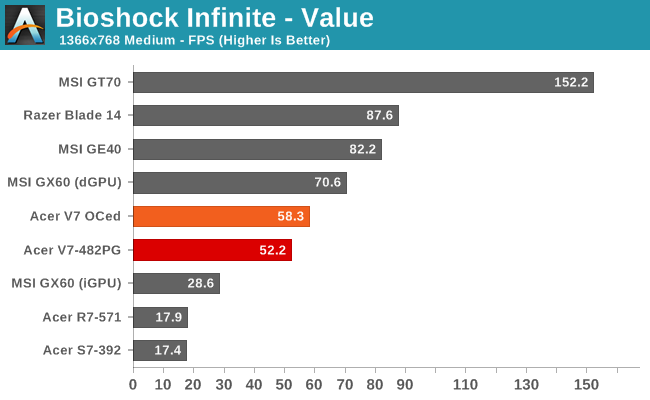
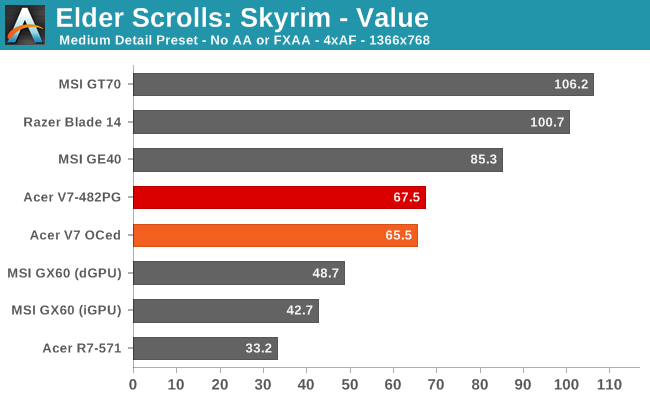
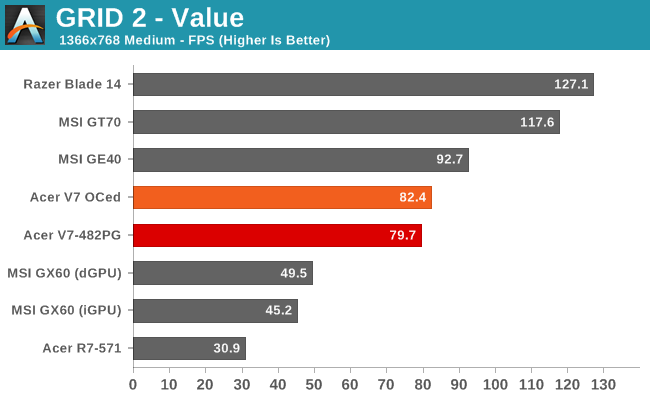

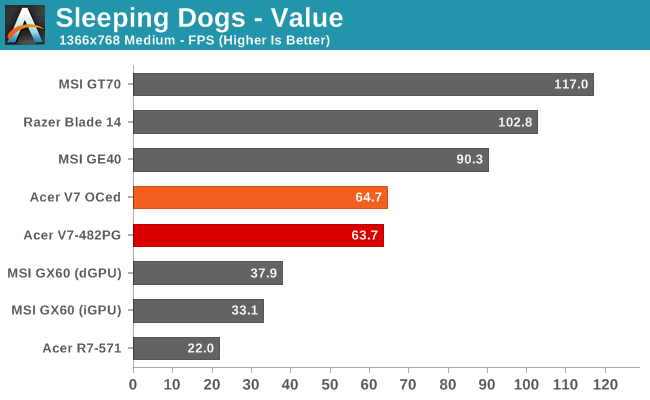
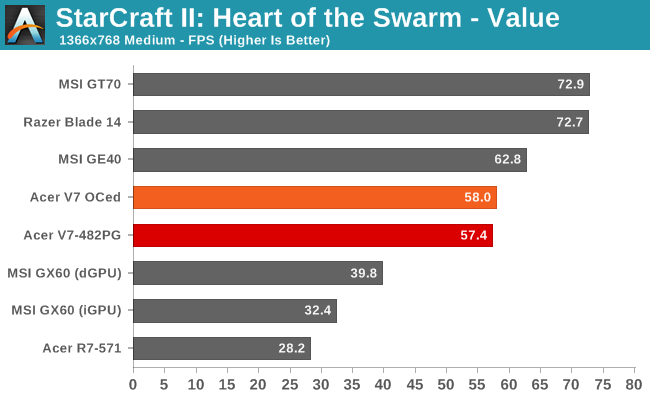
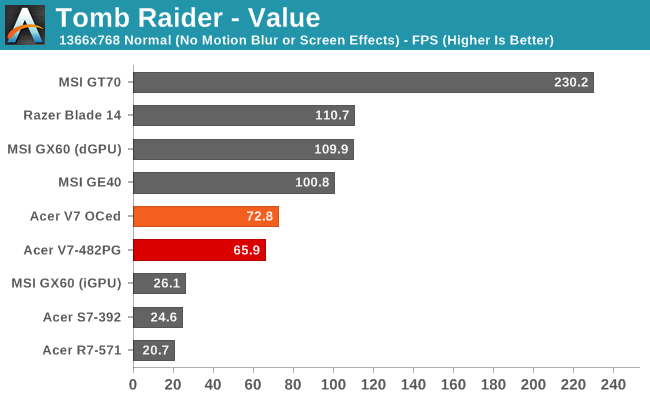
Mainstream Gaming Performance
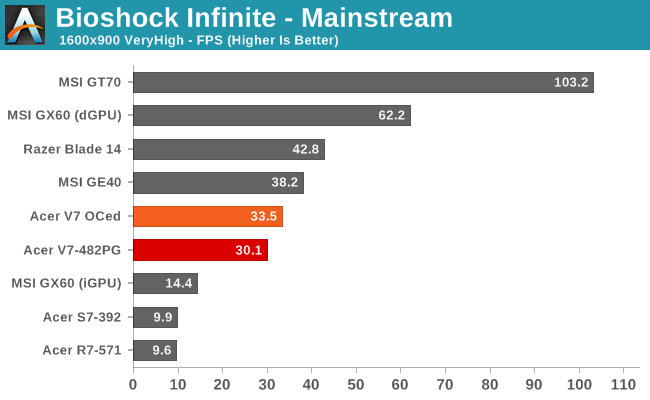

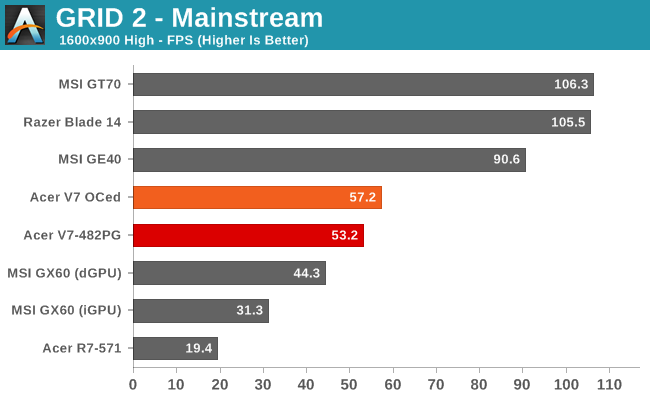
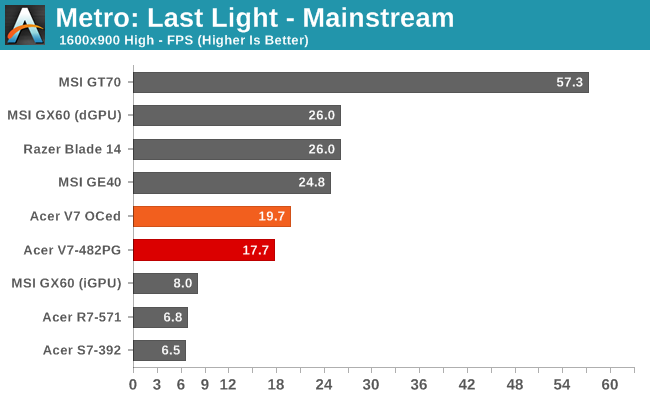
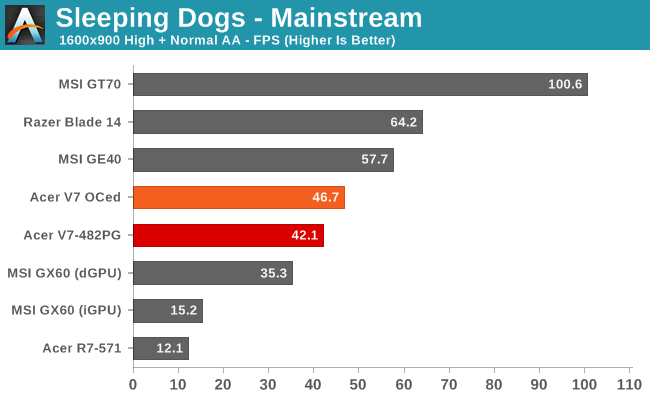


The two most demanding games in our test suite right now are Metro: Last Light and Company of Heroes 2 – I didn’t include graphs for the latter above, simply because we’ve only run it on three laptops so far, but it ends up being the slowest running game in our suite by far to the tune of 23.7 FPS at 1366x768 medium/low settings. It’s basically the opposite of StarCraft 2: Heart of the Swarm, where it apparently pounds the GPU (shaders) and doesn’t require as much of the CPU. Speaking of which, Skyrim and StarCraft 2 are in the interesting camp of being more CPU limited, so we actually see better numbers from the Aspire V7 with GT 750M than we get from the MSI GX60 with HD 7970M, even at our Mainstream settings. Somewhat surprisingly, GRID 2 and Sleeping Dogs also fall into that category, at least if we limit ourselves to the Mainstream settings.
It all goes back to what I was talking about in the introduction: balance. The Acer V7 is certainly not the fastest laptop on the block, and the GT 750M really has no business outperforming an HD 7970M. The problem is the CPU-GPU balance in the GX60 is just way off. In some games like Tomb Raider and Bioshock Infinity, even moderately slow CPUs are fast enough; in other cases, however, more (single-threaded) CPU performance is required. In an Ultrabook like the V7, I think the GT 750M is a pretty good fit for a Haswell ULT CPU.
My only wish is that Acer had equipped the GPU with 2GB GDDR5 memory; I don’t know exactly how much that would have helped, but simply overclocking the DDR3 memory by 22% produced some interesting results. At our less demanding Value settings, the overclock only improves performance by 3.6% on average, and in one game at least (Skyrim) it was actually slightly slower. The reason for the lack of improvement is that Value settings tend to be more CPU constrained, so increasing the GPU performance doesn't always help much; still, Bioshock and Tomb Raider both improve by over 10%. Move up to the Mainstream settings and the increased memory bandwidth becomes far more useful. There we see an average performance increase of 11.5%, and only Skyrim and GRID 2 fail to post double digit percentage improvements.
If all of this can be achieved with a 22% overclock of DDR3 RAM, what would more than doubling the bandwidth with GDDR5 accomplish? It definitely wouldn't reduce performance, and I wouldn’t be surprised to see an extra 15-30% performance increase at our Mainstream settings for a relatively minor change in BOM costs. Even without GDDR5, though, the Acer V7 posts respectible numbers and can handle most games at 1080p and Medium detail. It's not a gaming enthusiasts dream laptop, but for less demanding gamers it's more than sufficient.










62 Comments
View All Comments
JarredWalton - Saturday, August 24, 2013 - link
The "silliness" was more in reference to the hidden torx screws under the pads. Let me clarify that in the text.evilspoons - Saturday, August 24, 2013 - link
Yes! Torx screws are better given the same physical size, and the screwdrivers aren't exactly expensive or anything. I'd much rather have to spend an extra five minutes finding a Torx driver than strip out a friggin' Philips.KaarlisK - Saturday, August 24, 2013 - link
In 2011, I bought a laptop that weights 1.7kg and has a 35W TDP CPU, and as a result, the CPU and the integrated graphics could actually both boost at the same time.Now we're being offered 1.9-2.5 kilo laptops with 17W CPUs and rather inconsistent performance, especially in games.
It seems silly, especially since the idle power consumption is the mostly same and the prices, at least for Ivy Bridge, were mostly similar.
mtoma - Saturday, August 24, 2013 - link
I think Jarred (and many other ethusiasts) have huge expectations from the displays. Sure, everybody wants 1080p (or higher) IPS displays, but at what cost? Let's not forget that many people don't have many thousands of dollars per month in order to afford such beautiful displays/products. For example, why should'nt be enough an 720p or IPS panel on a 14 or 15 inch laptop? I remember back in 2007 I had an 15,6 inch Fujitsu laptop with a 1280x800 pixels. It wasn't great at all, but it was getting the work done. Remember, a greater display resolution demands much more from the graphichs, and that leads to bigger power consumption. More doesn't always mean better.Regards,
KaarlisK - Saturday, August 24, 2013 - link
A better display is simply _the_ worthwhile upgrade in the era of "good enough" computing.I have a Sandy i3 laptop and a Core 2 Duo desktop, and since I do not much game (or convert videos/run scientific simulations), I still do not feel a need to upgrade my CPU (I do have fast storage and lots of RAM).
More and more I've been catching myself on the thought that my next upgrade might be a ~24'' monitor with high DPI, if one arrives for a reasonable price. With the laptop it is similar – it does everything it is asked to, so the only incentive to upgrade is either a way better screen (better colors and high DPI), or the same performance and OS support in a tablet/phone sized package.
sheh - Saturday, August 24, 2013 - link
Nevermind the resolution, a poor TN is a horrible thing. I'd want laptop makers to use *decent* TNs as minimum, though really I'd prefer something better than TN (with decent response pixel times).I recently got an Asus 15.6" laptop (500-600$ in the US). The TN screen is horrendous. The specs say it's something like 15+30 degrees vertically, but that's a lie. It's more like 0 degrees. There's no single angle where you can see the whole screen undistorted. Maybe if you watch it from 2-3 meter away. Horizontal angles aren't good either, but are less of a problem. I wonder why they don't rotate the panel 90 degrees, as vertical is more important in laptops. The 6-bit dithering is not difficult to notice. The pixel response time isn't too good. And looking at technical specs, it seems there are even worse TN screens being made!
Now, you can get such panels on eBay for about $50. That's for a very poor 6-bit 1366x768 TN. For $150 you can get a 15.6" 1920x1080 S-IPS 10-bit. $100 difference in end user price going from super poor to very good:
http://www.ebay.com/itm/New-15-6-Laptop-LCD-Screen...
You can probably find decent 6-bit 1366x768 IPSes for less than $100.
sheh - Saturday, August 24, 2013 - link
BTW, I didn't say anything about contrast because I don't know what it is. The contrast is variable across the screen (mostly vertically), as are the colors (is this pink or orange? is it dark purple or light? is there a vertical gradient here or is it a solid color?).Pfffman - Saturday, August 24, 2013 - link
I don't think Jarred expects people to buy laptops monthly let alone every year so investing in a nicer screen is still reasonable.When the asking price for the laptop is $1300, 1080 would seem to be expected. Touch is a nice extra. Generally Anandtech will scale their screen expectations according to price. They do have a high emphasis on screen though. They generally only okay TN panels if they are the really good ones or the laptop is clearly budget targeted.
In this time, it might be hard to get a 1280x720 or 1280x800 IPS screen at 14 inch. The panel manufacturers might not bother with it any more.
piroroadkill - Sunday, August 25, 2013 - link
While your old laptop may have had a crap display - many others had old laptops which did not. I have a laptop from 2004~ that has a 15" 1920x1200 screen, a Dell Precision which also has a 15" 1920x1200 screen, an old Dell with a 1400x1050 14".. etc.My favourite laptop and the one I'm on right now is a Sony Vaio Z12, 13.3" 1600x900, and so light. But I added the previous examples to show that some people have ALREADY had higher res screens, and are bewildered that options lack today.
I think the screen on this particular Acer is probably just fine - once calibrated, so they probably should do that from the factory - but I honestly would love to drop the touchscreen entirely, and have a matte finish. But that's me. It would even save some money.
dareo - Saturday, August 24, 2013 - link
"The V7-582PG-6421 has a 15.6” 1080p IPS display, but the CPU is a Core i5-4200U and the GPU is a rather questionable GT 720M"I've been considering this model mainly because of the larger display, which only adds 0.5 lbs to the weight, and my eyes aren’t what they used to be so the extra screen real estate is needed. It would be great if it were as light as some previous generations of the Samsung Series 9, but you can’t have everything.
Taking into account the following use cases, will the lower CPU & GPU specs on the 6421 really make a difference to me?:
At home office (connected to an external 24” monitor):
- Word, Excel, Powerpoint
- email
- web browsing
- occasional hobbyist use of 3D Home Architect
On the road:
- Word, Excel, Powerpoint
- email
- web browsing
- watching videos on flights
While display size at home is irrelevant since I have the external monitor, I find that my current laptop with a 13.3” display doesn’t cut it (for me) on the road when working with the MS-Office suite. Since the laptop is nearly 4 years old and starting to give me some problems, the timing of the new Haswell-based laptops is spot on and I’m looking to get one by the end of the year. Right now there just doesn’t seem to be too many options for a new generation (processor & touchscreen) 15” minimal-compromise ultrabook at a decent price. Calling the V7-582PG-6421 an ultrabook might be a stretch, but it weights the same as my current smaller-screen laptop so it’s acceptable.
Should I be waiting for something else that’s just on the horizon? Are there other alternatives to the V7-582PG-6421 that I should be considering?